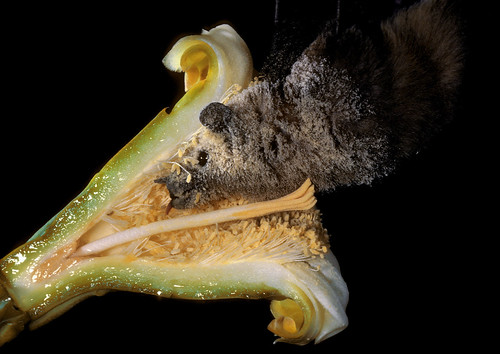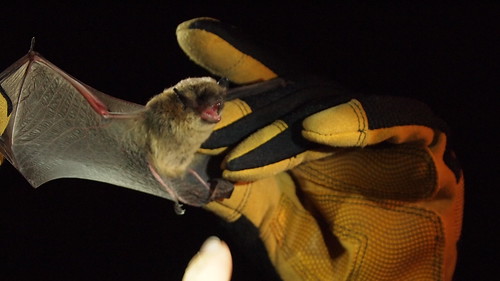
Mexican free-tailed bats exiting Bracken Bat Cave. Photo credit: USFWS/Ann Froschauer
Most people associate pollination with bees and birds but often forget the work of their furry colleagues: bats. Bats take the night shift, playing a major role in pollinating crops and spreading seeds.
One important bat is the Mexican long-nose bat, which dwells in large colonies. Their range includes the southern parts of Texas, California, New Mexico and Arizona.
Throughout time, plants and mammals have shared a dependency on one another that is mutually beneficial. So naturally, these bats feed on flowers, including those of valuable commercial crops, like figs, dates, mangoes and peaches, which have flowers that only open at night.
These mammal pollinators are finicky eaters with a specific palate. Dining on plant pollen and drinking sweet nectar is a delicacy at its batty-best. They tend to enjoy a flower that’s mild in scent and not bright in color. Simply speaking, white or pale crop flowers attract the night pollinators to feed on them.
Mexican long-nose bats can fly extensive distances to gather nectar from specific plants.

A lesser long-nosed bat pollinates a cross section of a saguaro cactus flower. Photo by Merlin D. Tuttle, Bat Conservation International.
“When they are in Texas and New Mexico, they feed on the nectar of agave flowers too,” said Cyndee Watson, a wildlife biologist with the U.S. Fish and Wildlife Service.
The common feeding features of pollinating bats are elongated snouts and tongues, combined with smaller and fewer teeth. This aids in the rapid collection of nectar.
“Bats get pollen on their faces and bodies and go to the next flower. That is how cross pollination happens,” Watson said.
Mexican long-nose bats visit up to 30 flowers each night, feeding and transporting pollen.
They use a sonar system, through which the echoes of sound waves determine the shapes of surrounding objects. Because the powerful echoes emit higher frequencies and vibrations, bats can detect the existence of swift flying predators, too.
The seeds and fruits that compose part of our diet would not exist without the interaction between flowering plants and pollinators, including bats. Bats serve a purpose with other popular pollinators, and they’re just as important as the day shift birds and bees, which feed on daytime flowering plants.
Some states where large populations of bats live are also working to ensure bats always have a place to call home after a nighttime feeding.
“Texas is trying to install bat condo structures where the furry friends can make a home,” said James Rogers, a wildlife biologist with USDA’s Natural Resources Conservation Service.
NRCS works with farmers, ranchers and forest landowners to implement conservation practices on the ground that have numerous environmental benefits, including ones that provide habitat and food for pollinators.
For example, through the 2014 Farm Bill, landowners have an opportunity to receive financial assistance through conservation programs and practices, which can include planting cover crops and riparian buffers that target these beneficial pollinators. Bats’ survival depends on improved conservation practices to ensure they have healthy ecosystems to hang around in.

Throughout the summer, wildlife biologists conduct nighttime surveys to learn more about the many bats that live in the Coconino National Forest. Scientists gather information about species, population, and habitat. This bat from the genus Myotis is having its wing examined. Credit: USDA Forest Service, Coconino National Forest
No comments:
Post a Comment
Note: Only a member of this blog may post a comment.